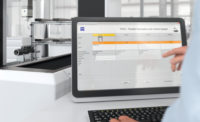Utilizing CMM Data
Easily import results from CMM reports and incorporate the values into the ballooned drawing and inspection reports.

First article inspection is a vital part of the manufacturing process for many companies.
Advanced Inspection Services explains the first article inspection process, “When you are working on a prototype design, you want to verify the accuracy of the drawings and any changes made to the parts. Sometimes you want to verify the production process instead of focusing on the critical dimensions or you want to verify that all the tooling is capable of producing the parts to specifications.”
With so much at stake, companies have very specific guidelines on how to accomplish this task.
BAE Systems is no different. With headquarters in Arlington, VA, the company’s work spans the globe. The company employs “approximately 35,100 across its major operations in the United States, United Kingdom, Sweden, and Israel, and generated 2019 sales of $11.4 billion.”
With such a large operation, suppliers—and first article inspection reports—are critical. According to the company’s Supplier Requirements For First Article Inspection Reports, “The purpose of an FAI plan is to document the activities to achieve the minimum requirements for the supplier to successfully complete the FAIR per AS9102 and BAE Systems Specification B25279.” The guidelines go on to say that “The supplier shall have a process to plan for completion of the required FAI or shall plan FAI activities prior to the first production run. FAI planning shall address the activities to be performed throughout the FAI / manufacturing process and define the responsible groups of those activities.”
Following the FAI requirements is not something left to chance. Any processes prone to error should be eliminated. And this goes for CMM data as well. The BAE requirements clearly detail how these should be addressed in their supplier guidelines.
For example, the supplier requirements specify: “When automated inspection/tooling measurement is used to record pass/fail results, Coordinate Measuring Machine (CMM) or any automated inspection report shall be attached with the FAIR.
- All characteristic numbers shall be linked in the attached report.
- The results in the attached reports shall be traceable to the characteristic numbers.
- The results are directly equivalent to the design characteristic.
NOTE: Coordinate Measurement Machine (CMM) data alone would not be acceptable for a positional tolerance; the results shall show the actual positional value. CMM positional values (results) do not need to be listed on form 3 if these values are listed in the CMM report.”
CMM data is an important part of the first article inspection process, so it is critical to make sure that the data is transferred in a way that minimizes—or eliminates—the potential for error.
If you’ve wanted to import results from a CMM report from a common CMM program, you’re in luck. With the right software, that is entirely possible. It would also be possible to use the measurement values from the CMM report and use them in the bill of characteristics, without any additional software on the CMM. It is also possible to reverse-engineer or “backfill” a bill of characteristics and ballooned drawing from the CMM report.
The advantages of using a software that allows this would be a reduced labor effort in importing results from CMM reports into formal inspection reports that customers require. It also would enable the efficient creation of professional FAI reports and ballooned drawings directly from CMM reports. Finally, the right software could automate the verification of CMM results versus characteristic requirements using the bill of characteristics.
For one aerospace company, having the right solution has been invaluable in the FAI process. Magellan Aerospace supplies complex, engineered products and services for the largest aerospace companies on the globe. This company provides complex assemblies and systems solutions to aircraft and engine manufacturers, and defense and space agencies around the world, with operating units throughout North America, Europe, and India.
When you’re making rockets, there is no room for error. And, as with any manufacturing operation, time is often in short supply as well. “We are striving to eliminate the amount of time spent transferring PC-DMIS CMM Report results onto the inspection reports as well as the FAI reports. DISCUS CMM is a great tool for this task, with the new CSV format in the DISCUS CMM module it will become less time consuming to achieve this goal. We look forward to working with DISCUS,” Alejandra Ortega, CMM programmer, Magellan Aerospace – Ellanef Mfg. Corp., explained in a DISCUS testimonial.
As DISCUS says, “One of the great capabilities of the DISCUS CMM Module is the ability to identify and preclude errors. At the top of the CMM report panel, our metrics that show inconsistencies or issues between the BOC and the CMM report, these are all updated in real time. If there is a tolerance mismatch or other inconsistency, DISCUS will catch this and warn us.”
Preventing errors is obviously an issue dear to any quality professional’s heart. If you are looking to improve your first article inspection process, this type of module may help in that endeavor.
Looking for a reprint of this article?
From high-res PDFs to custom plaques, order your copy today!







